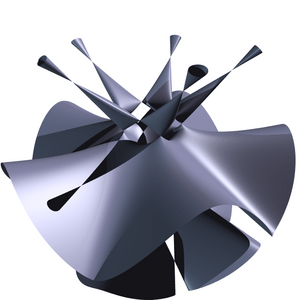Algebraic geometry facts for kids
Algebraic geometry is a branch of mathematics. It helps us study shapes and curves using polynomial equations. These equations are like recipes for drawing geometric figures. Modern algebraic geometry uses ideas from abstract algebra, especially commutative algebra. It combines the language of algebra with the problems of geometry.
Contents
What is Algebraic Geometry?
The main things studied in algebraic geometry are called algebraic varieties. These are like geometric pictures of the solutions to sets of polynomial equations. Imagine you have an equation like y = x + 1. This equation draws a straight line. That line is a simple algebraic variety.
Examples of Algebraic Shapes
Some common examples of algebraic varieties are plane algebraic curves. These include:
- Lines
- Circles
- Parabolas
- Ellipses
- Hyperbolas
- Cubic curves, like elliptic curves
- Quartic curves, like lemniscates and Cassini ovals
A point on a plane belongs to an algebraic curve if its coordinates fit the curve's polynomial equation. For example, if you have the equation for a circle, any point on that circle will make the equation true.
Studying Special Points
In algebraic geometry, mathematicians look at special points on these curves. These can be:
- Singular points: Places where the curve might cross itself or have a sharp corner.
- Inflection points: Where the curve changes how it bends.
- Points at infinity: Special points that help us understand curves in a broader way.
More advanced studies look at the overall shape of the curve. This includes its topology, which is like studying how a shape can be stretched or bent without tearing. They also look at how different curves relate to each other.
Why is it Important?
Algebraic geometry is very important in modern mathematics. Its ideas connect it to many different areas. These include complex analysis, topology, and number theory.
At first, algebraic geometry was about solving systems of polynomial equations. But it goes beyond just finding solutions. Often, understanding the properties of all solutions is more important than finding just one. This leads to some of the deepest ideas and techniques in all of mathematics.
Different Areas of Study
In the 20th century, algebraic geometry grew into several different sub-areas:
- Mainstream Algebraic Geometry: This part focuses on points of algebraic varieties that use complex numbers. It also looks at points with coordinates in an algebraically closed field.
- Arithmetic Geometry: This area studies points of algebraic varieties using rational numbers or other number fields. It is also known as Diophantine geometry. It is a part of algebraic number theory. A famous example of its power is Wiles's proof of Fermat's Last Theorem.
- Real Algebraic Geometry: This field looks at the points of an algebraic variety that are real numbers.
- Singularity Theory: A big part of this field studies the "singularities" or unusual points on algebraic varieties.
- Computational Algebraic Geometry: When computers became common, this field grew. It combines algebraic geometry with computer algebra. It focuses on creating algorithms and software to study and find properties of algebraic varieties.
Much of the progress in algebraic geometry in the 20th century used abstract algebra. It focused on properties of algebraic varieties that don't depend on how they are placed in a coordinate system. This is similar to how topology and differential geometry developed.
Images for kids
See also
 In Spanish: Geometría algebraica para niños
In Spanish: Geometría algebraica para niños




